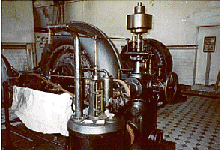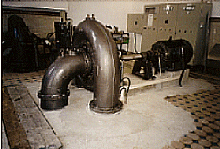Refurbished Turbines
After World War II when the energy demand in Germany rose constantly the nuclear-energy-focused policies of the larger energy concerns were concentrated on eliminating small and smallest competitors. In addition in the 1950s and 1960s many mills and factories that had operated own hydropower stations were closed down or did not carry on operation because the output was too low and the energy suppliers would not compensate energy, fed back into the grid. Finally until 1979 private producers of electric energy were prohibited to enter the grid, even to produce energy for their own demand.
This development resulted in an enormous mass of disused hydropower stations that sat there rusting away year by year, waiting for better times. Some of them were demolished. But many of them still were there when in the beginning of the 1980s hydropower returned into public interest. Also Mr. Heidemann realized that these disused turbines would be worth salvaging and putting in stock, which he started in 1981.
Nowadays "second hand" turbines are an important part of the small hydro market. Their greatest advantage doubtless is the price that can be down to 40% of the costs of a new unit, which appeals to planners of small hydropower stations.
from the experience with several refurbished units, that had been commissioned since 1987 it can be said, that in terms of performance most of those turbines in the medium and low head range and with outputs of approx. 400 kW would only marginally stand back from today´s designs, even though they had been manufactured between 1900 and 1960
Heidemann Wasserkraftanlagen has a large number of these turbines and auxiliary equipment available and access to many other stores of cooperating companies.
Refurbished turbines have passed an intense treatment from extra carefully dismantling and transportation, sandblasting the parts to be reused, defining repair measurements, replacing parts that are beyond repair, doing the whole range of work on the parts to reshape worn down edges and profiles, refill cavitations or pittings by welding or plastering with special putty etc. replacing bushings, bearings, bolts and minor parts and so on, until the whole machine has been assembled testwise and finds its place in the store, waiting for its new home.



